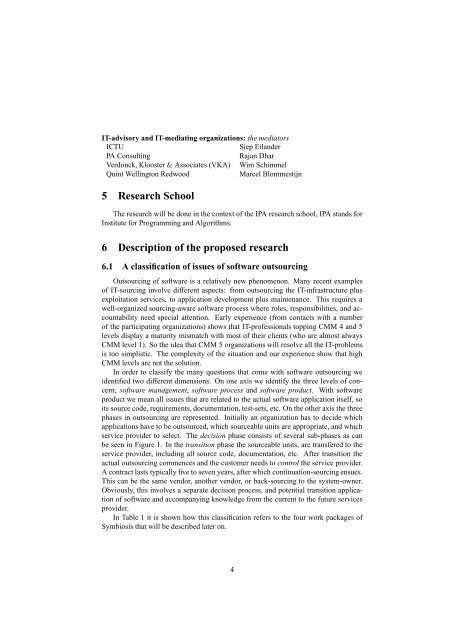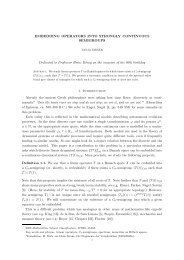Symbiosis - Universiteit van Amsterdam
Symbiosis - Universiteit van Amsterdam
Symbiosis - Universiteit van Amsterdam
Create successful ePaper yourself
Turn your PDF publications into a flip-book with our unique Google optimized e-Paper software.
IT-advisory and IT-mediating organizations: the mediators<br />
ICTU Siep Eilander<br />
PA Consulting Rajan Dhar<br />
Verdonck, Klooster & Associates (VKA) Wim Schimmel<br />
Quint Wellington Redwood Marcel Blommestijn<br />
5 Research School<br />
The research will be done in the context of the IPA research school, IPA stands for<br />
Institute for Programming and Algorithms.<br />
6 Description of the proposed research<br />
6.1 A classification of issues of software outsourcing<br />
Outsourcing of software is a relatively new phenomenon. Many recent examples<br />
of IT-sourcing involve different aspects: from outsourcing the IT-infrastructure plus<br />
exploitation services, to application development plus maintenance. This requires a<br />
well-organized sourcing-aware software process where roles, responsibilities, and accountability<br />
need special attention. Early experience (from contacts with a number<br />
of the participating organizations) shows that IT-professionals topping CMM 4 and 5<br />
levels display a maturity mismatch with most of their clients (who are almost always<br />
CMM level 1). So the idea that CMM 5 organizations will resolve all the IT-problems<br />
is too simplistic. The complexity of the situation and our experience show that high<br />
CMM levels are not the solution.<br />
In order to classify the many questions that come with software outsourcing we<br />
identified two different dimensions. On one axis we identify the three levels of concern,<br />
software management, software process and software product. With software<br />
product we mean all issues that are related to the actual software application itself, so<br />
its source code, requirements, documentation, test-sets, etc. On the other axis the three<br />
phases in outsourcing are represented. Initially an organization has to decide which<br />
applications have to be outsourced, which sourceable units are appropriate, and which<br />
service provider to select. The decision phase consists of several sub-phases as can<br />
be seen in Figure 1. In the transition phase the sourceable units, are transfered to the<br />
service provider, including all source code, documentation, etc. After transition the<br />
actual outsourcing commences and the customer needs to control the service provider.<br />
A contract lasts typically five to seven years, after which continuation-sourcing ensues.<br />
This can be the same vendor, another vendor, or back-sourcing to the system-owner.<br />
Obviously, this involves a separate decision process, and potential transition application<br />
of software and accompanying knowledge from the current to the future services<br />
provider.<br />
In Table 1 it is shown how this classification refers to the four work packages of<br />
<strong>Symbiosis</strong> that will be described later on.<br />
4

















